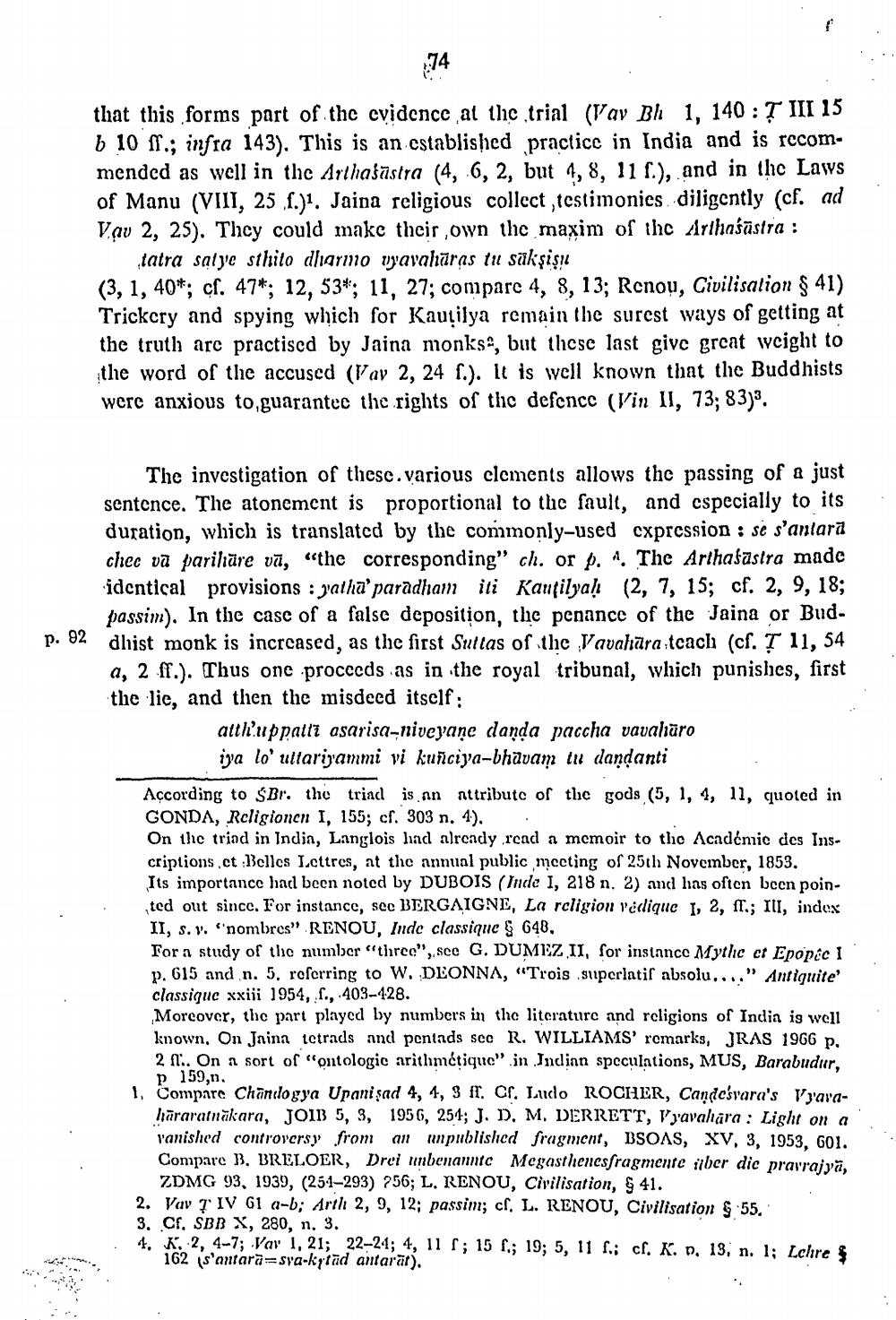________________
that this forms part of the evidence at the trial (Vay Bh 1, 140:7 III 15 b 10 fl.; infra 143). This is an established practice in India and is recommended as well in the Arthasāstra (4, 6, 2, but 4, 8, 111.), and in the Laws of Manu (VIII, 25.1.). Jaina religious collect testimonies diligently (cf. ad Vav 2, 25). They could make their own the maxim of thc Arthaśāstra :
tatra salye sthito dharmo vyavahāras til sak şiş (3, 1, 40*; çf. 47*; 12, 53*; 11, 27; comparc 4, 8, 13; Renoy, Civilisation § 41) Trickcry and spying which for Kauļilya remain the surest ways of getting at the truth arc practised by Jaina monks, but these last give great wcight to the word of the accused (Vay 2, 24 f.). It is well known that the Buddhists were anxious to guarantee the rights of the defence (Vin II, 73; 83)3.
p. 92
The investigation of these. various clements allows the passing of a just sentence. The atonement is proportional to the fault, and cspecially to its duration, which is translated by the commonly-used expression : sé s'antara chec va parilāre vü, “the corresponding" ch. or p. 4. The Arthasastra made identical provisions : patha' paradham iti Kautilyal (2, 7, 15; cf. 2, 9, 18; passim). In the case of a false deposition, the penance of the Jaina or Buddhist monk is increased, as the first Sullas of the Vavahāra tcach (cf. T 11, 54 a, 2 ff.). Thus one proceeds as in the royal tribunal, which punishes, first the lie, and then the misdeed itself:
attl’uppatti asarisa-niveyane danda paccha vavaliüro
iya lo' ullariyammi vi kunciya-bhavam tu dandanti According to SBr. the triad is an attributc of the gods (5, 1, 4, 11, quoted in GONDA, Rcligionen I, 155; cf. 303 n. 4). . On the triod in India, Langlois liad already read a memoir to the Académie des Inscriptions.ct Belles lettres, at the annual public mecting of 25th November, 1853. Its importance had been noted by DUBOIS (Inde I, 218 n. 2) and has often bccn pointed out since. For instance, sec BERGAIGNE, La rcligion Yedique 1, 2, ff.; III, index II, s. v. "nombres" RENOU, Inde classique & 648, For a study of the number "thrce", see G. DUMEZII, for instance Mythc et Epopec I p. 615 and n. 5, referring to W. DLONNA, "Trois superlatif absolu...." Antignite' classique xxiji 1954,.., 403-428. Moreover, the part played by numbers in the literature and religions of India is well known, On Jaina tetrads and pentads sec R. WILLIAMS' remarks, JRAS 1966 p. 2 fr.. On a sort of "ontologic arithmétique" in Indinn speculations, MUS, Barabudur, p 159,n. Compare Chandogya Upanişad 4, 4, 3 ff. cf. Ludo ROCHER, Candesvara's Vyavahāraratnākara, JOIB 5, 3, 1956, 254; J. D. M. DERRETT, Vyavahara : Light on a vanished controversy from an unpublished fragment, BSOAS, XV, 3, 1953, 601. Compare B, BRELOER, Drei umbenanntc Megasthenesfragmente iber dic pravrajyä,
ZDMG 93, 1939, (251–293) 256; L. RENOU, Civilisation, S 41. 2. Vav T IV 61 a-b; Arth 2, 9, 12; passim; cf. L. RENOU, Civilisation & 55. 3. Cf. SBB X, 280, n. 3. 4. K. 2, 4-7; Vay 1, 21; 22-24; 4, 11 ; 15 f.; 19; 5, 11 f.; cf. K. p. 13, n. 1; Lehre
162 s'antara=sya-kytad antarāt).




